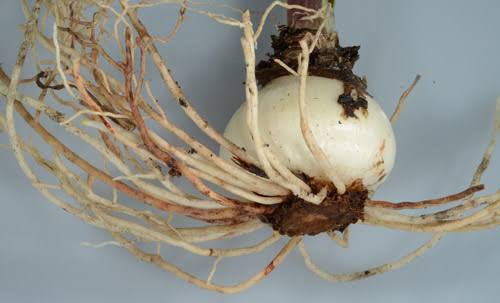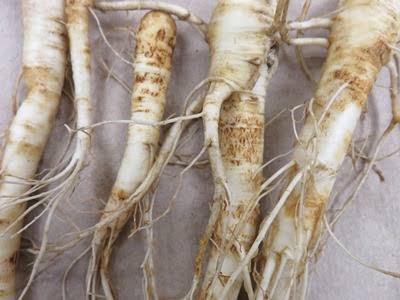Lesion nematodes, scientifically known as Pratylenchus spp., are tiny, worm-like organisms that can have a significant impact on various plants. These microscopic creatures live in the soil and feed on the roots of plants, causing lesions or wounds that can hinder the plant’s growth and overall health.
These nematodes are a common concern in agriculture because they can infect a wide range of crops, including cereals, vegetables, and fruits. Farmers often face challenges in managing these pests, as they can lead to yield losses and economic setbacks.
Lesion nematodes are quite adaptable and can thrive in different soil types and climates. They move through the soil water film and use their stylet, a needle-like mouthpart, to pierce and feed on plant roots. This feeding activity disrupts the normal functioning of the roots, affecting the plant’s ability to absorb nutrients and water.
Plants infested with lesion nematodes often exhibit symptoms such as stunted growth, yellowing of leaves, and a general decline in vigor. These symptoms can be mistaken for other plant diseases or nutrient deficiencies, making it essential for farmers to diagnose the presence of lesion nematodes accurately.
Crop rotation and the use of nematode-resistant plant varieties are among the strategies employed to manage lesion nematodes. However, developing effective control measures remains a challenge due to the nematodes’ ability to adapt and survive in diverse environments.
Researchers continue to explore biological and chemical methods to control lesion nematodes while minimizing environmental impact. Nematode management strategies often involve a combination of approaches, as relying solely on one method may not provide sufficient control.
However, lesion nematodes pose a considerable threat to agriculture, affecting the productivity of various crops. Ongoing research aims to enhance our understanding of these nematodes and develop sustainable management practices to mitigate their impact on global food production.
Read Also: How to Farm and Care for Bigeye Scad Fish (Selar crumenophthalmus)
Plants Affected by Lesion Nematodes (Pratylenchus spp.)

Lesion nematodes, scientifically known as Pratylenchus spp., have a broad host range, affecting a wide variety of plants. These microscopic pests can infest many crops, leading to detrimental effects on plant health and productivity.
Cereals such as wheat, barley, oats, and rye are susceptible to lesion nematodes. These nematodes can cause damage to the roots of these cereal crops, affecting their ability to take up nutrients and water, ultimately impacting yield.
Legumes, including soybeans, peas, and lentils, are also among the plants affected by lesion nematodes. The nematodes’ feeding activity on the roots can compromise the plants’ overall growth and nitrogen-fixing abilities.
Root and tuber crops like potatoes, carrots, and sweet potatoes are not spared from lesion nematode infestations. These pests can lead to reduced tuber quality and yield, impacting the economic value of these important food crops.
Fruits such as apples, grapes, and strawberries can also be affected by lesion nematodes. The damage caused to the roots can result in decreased fruit quality and quantity, affecting both commercial and backyard fruit production.
Vegetables, including tomatoes, peppers, and onions, are not immune to the impact of lesion nematodes. Infestations can lead to stunted growth, wilting, and reduced overall productivity in these crops.
It is important for farmers and researchers to be aware of the diverse range of plants susceptible to lesion nematodes. Understanding the host range helps in developing effective management strategies to minimize the economic losses caused by these microscopic pests across various agricultural sectors.
Damages Caused by Lesion Nematodes
Lesion nematodes, scientifically known as Pratylenchus spp., inflict significant damage to plants, impacting their growth, development, and overall productivity. The damages caused by these microscopic pests are diverse and can have profound consequences for various crops.
1. Root Damage: Lesion nematodes primarily target plant roots, using their needle-like mouthparts to feed on root tissues. This feeding activity creates wounds and lesions on the roots, disrupting the normal functioning of the plant’s root system. Damaged roots are less efficient in absorbing water and nutrients from the soil.
2. Stunted Growth: The feeding activities of lesion nematodes impede the growth of plants. As the nematodes damage the root system, the affected plants struggle to develop properly. This often results in stunted growth, with plants failing to reach their full potential in terms of height and size.
3. Reduced Nutrient Uptake: The compromised root system not only affects water absorption but also hinders the plant’s ability to take up essential nutrients from the soil. This can lead to nutrient deficiencies in the plants, manifesting as symptoms such as yellowing of leaves and overall poor vigor.
4. Wilting and Yellowing: Infested plants commonly exhibit symptoms of stress, including wilting and yellowing of leaves. These visual indicators are a result of the nematodes’ impact on the plant’s water and nutrient uptake capabilities, causing physiological stress.
5. Yield Loss: Perhaps the most economically significant damage caused by lesion nematodes is the reduction in crop yield. Stunted growth, poor root health, and compromised nutrient absorption collectively contribute to lower yields in affected crops. This can result in financial losses for farmers and impact food production.
6. Secondary Infections: The wounds and lesions created by lesion nematodes provide entry points for other pathogens, such as bacteria and fungi. This makes plants more susceptible to secondary infections, further exacerbating the overall damage.
7. Quality Reduction: Beyond quantity, the quality of harvested produce is also affected. Fruits, vegetables, and tubers may show reduced quality due to the impact of lesion nematodes on their development and physiological processes.
The damages caused by lesion nematodes encompass a range of adverse effects on plant health and productivity. Efforts to manage and control these nematodes are crucial for sustaining agricultural yields and ensuring food security.
Read Also: How to Farm and Care for Yellowstripe Scad Fish (Selaroides leptolepis)
Control and Preventive Measures

Managing lesion nematodes requires a combination of control and preventive measures to minimize their impact on crops. Various strategies are employed by farmers and researchers to mitigate the damages caused by these microscopic pests:
1. Crop Rotation: Rotating crops is a common practice to disrupt the life cycle of lesion nematodes. By alternating crops, the nematodes encounter unfavorable conditions for reproduction and survival, helping reduce their population in the soil.
2. Nematode-Resistant Varieties: Planting crop varieties that exhibit resistance or tolerance to lesion nematodes can be an effective strategy. Breeding programs aim to develop and promote varieties with built-in resistance to limit nematode damage.
3. Soil Solarization: Exposing the soil to high temperatures through solarization can help control lesion nematodes. This process involves covering the soil with transparent plastic, trapping solar heat and creating conditions that are detrimental to nematode survival.
4. Cover Crops: Planting cover crops like marigold and mustard can help suppress lesion nematode populations. Some cover crops release natural compounds that are toxic to nematodes, contributing to their control.
5. Biological Control: Introducing beneficial organisms, such as nematophagous fungi and predatory nematodes, can help in controlling lesion nematode populations. These organisms prey on or parasitize the nematodes, acting as natural antagonists.
6. Organic Amendments: Adding organic matter to the soil, such as compost or well-rotted manure, can improve soil health and create conditions less favorable for lesion nematodes. Healthy soils with diverse microbial communities can help suppress nematode populations.
7. Chemical Nematicides: While chemical nematicides are an option, they are often used cautiously due to their potential environmental impact. Application of specific nematicides may be considered in cases of severe infestations, following recommended guidelines and safety measures.
8. Monitoring and Early Detection: Regularly monitoring crops for symptoms of nematode damage and conducting soil tests can aid in early detection. Early intervention is crucial for implementing control measures before nematode populations become excessive.
9. Good Agricultural Practices: Implementing good agricultural practices, such as proper irrigation management and maintaining optimal soil fertility, can contribute to overall plant health and resilience against nematode damage.
10. Quarantine Measures: Implementing quarantine measures, especially when introducing new plants or soil, can help prevent the spread of lesion nematodes to uninfested areas.
Additionally, an integrated approach combining cultural, biological, and chemical measures is essential for effective control and prevention of lesion nematode infestations. Customized strategies based on specific crops, environmental conditions, and local factors contribute to successful nematode management.
Frequently Asked Questions (FAQs) About Lesion Nematodes (Pratylenchus spp.)
Q1: What are lesion nematodes, and how do they affect plants?
A: Lesion nematodes, scientifically known as Pratylenchus spp., are microscopic worms that feed on plant roots, causing lesions and damage. They impact plants by hindering root function, leading to stunted growth, nutrient deficiencies, and overall reduced productivity.
Q2: Which plants are commonly affected by lesion nematodes?
A: Lesion nematodes have a broad host range and can affect various crops, including cereals (wheat, barley), legumes (soybeans, peas), root/tuber crops (potatoes, carrots), fruits (apples, grapes), and vegetables (tomatoes, peppers).
Q3: How can farmers identify if their crops are infested with lesion nematodes?
A: Symptoms include stunted growth, wilting, yellowing of leaves, and reduced vigor. Soil testing and examining root systems can help confirm nematode presence. Consulting with agricultural experts is advisable for accurate diagnosis.
Q4: What measures can farmers take to control lesion nematodes?
A: Strategies include crop rotation, planting nematode-resistant varieties, soil solarization, using cover crops, introducing biological controls, adding organic amendments, and, in severe cases, employing chemical nematicides following recommended guidelines.
Q5: Are there environmentally friendly methods to manage lesion nematodes?
A: Yes, environmentally friendly methods include crop rotation, cover cropping, biological control using nematophagous fungi, and improving soil health with organic amendments. These approaches aim to reduce nematode populations without adverse environmental impacts.
Q6: Can lesion nematodes be completely eradicated from the soil?
A: Complete eradication is challenging due to the nematodes’ adaptability and persistence. Integrated management practices can help control and reduce nematode populations, minimizing their impact on crops.
Q7: Are there specific varieties resistant to lesion nematodes?
A: Yes, some crop varieties are bred for resistance or tolerance to lesion nematodes. Planting these resistant varieties can help minimize nematode damage in susceptible crops.
Q8: How can farmers prevent the spread of lesion nematodes to new areas?
A: Implementing quarantine measures, such as careful monitoring of plant and soil movement, can help prevent the unintentional spread of lesion nematodes to new areas. Following good agricultural practices and avoiding contaminated equipment can also aid in prevention.
Q9: Can lesion nematodes cause economic losses in agriculture?
A: Yes, lesion nematodes can lead to significant economic losses by reducing crop yields and quality. Farmers may face financial setbacks due to the negative impact of these nematodes on various crops.
Q10: Are there ongoing research efforts to develop new methods for lesion nematode control?
A: Yes, researchers continue to explore and develop innovative methods for lesion nematode control, including biological control agents, resistant crop varieties, and sustainable soil management practices. Ongoing research aims to enhance our understanding and management of these pests.
Read Also: Top 30 Exceptional Features That Makes 10GYM Stand Out

